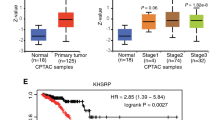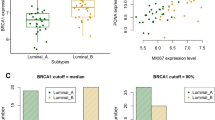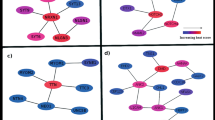Abstract
Kinase suppressor of Ras-1 (KSR1) facilitates signal transduction in Ras-dependent cancers, including pancreatic and lung carcinomas but its role in breast cancer has not been well studied. Here, we demonstrate for the first time it functions as a tumor suppressor in breast cancer in contrast to data in other tumors. Breast cancer patients (n>1000) with high KSR1 showed better disease-free and overall survival, results also supported by Oncomine analyses, microarray data (n=2878) and genomic data from paired tumor and cell-free DNA samples revealing loss of heterozygosity. KSR1 expression is associated with high breast cancer 1, early onset (BRCA1), high BRCA1-associated ring domain 1 (BARD1) and checkpoint kinase 1 (Chk1) levels. Phospho-profiling of major components of the canonical Ras-RAF-mitogen-activated protein kinases pathway showed no significant changes after KSR1 overexpression or silencing. Moreover, KSR1 stably transfected cells formed fewer and smaller size colonies compared to the parental ones, while in vivo mouse model also demonstrated that the growth of xenograft tumors overexpressing KSR1 was inhibited. The tumor suppressive action of KSR1 is BRCA1 dependent shown by 3D-matrigel and soft agar assays. KSR1 stabilizes BRCA1 protein levels by reducing BRCA1 ubiquitination through increasing BARD1 abundance. These data link these proteins in a continuum with clinical relevance and position KSR1 in the major oncoprotein pathways in breast tumorigenesis.
This is a preview of subscription content, access via your institution
Access options
Subscribe to this journal
Receive 50 print issues and online access
$259.00 per year
only $5.18 per issue
Buy this article
- Purchase on SpringerLink
- Instant access to full article PDF
Prices may be subject to local taxes which are calculated during checkout





Similar content being viewed by others
Change history
04 May 2021
A Correction to this paper has been published: https://doi.org/10.1038/s41388-021-01794-6
22 April 2021
A Correction to this paper has been published: https://doi.org/10.1038/s41388-021-01759-9
References
Ali S, Coombes RC . Endocrine-responsive breast cancer and strategies for combating resistance. Nat Rev Cancer 2002; 2: 101–112.
Stebbing J, Ngan S . Breast cancer (metastatic). Clin Evid (Online) 2010; 2010: 1–41.
Giamas G, Filipovic A, Jacob J, Messier W, Zhang H, Yang D et al. Kinome screening for regulators of the estrogen receptor identifies LMTK3 as a new therapeutic target in breast cancer. Nat Med 2011; 17: 715–719.
Kornfeld K, Hom DB, Horvitz HR . The ksr-1 gene encodes a novel protein kinase involved in Ras-mediated signaling in C. elegans. Cell 1995; 83: 903–913.
Therrien M, Chang HC, Solomon NM, Karim FD, Wassarman DA, Rubin GM . KSR a novel protein kinase required for RAS signal transduction. Cell 1995; 83: 879–888.
Sundaram M, Han M . The C. elegans ksr-1 gene encodes a novel Raf-related kinase involved in Ras-mediated signal transduction. Cell 1995; 83: 889–901.
Kolesnick R, Xing HR . Inflammatory bowel disease reveals the kinase activity of KSR1. The J Clin Invest 2004; 114: 1233–1237.
Zafrullah M, Yin X, Haimovitz-Friedman A, Fuks Z, Kolesnick R . Kinase suppressor of Ras transphosphorylates c-Raf-1. Biochem Biophys Res Communi 2009; 390: 434–440.
Goettel JA, Liang D, Hilliard VC, Edelblum KL, Broadus MR, Gould KL et al. KSR1 is a functional protein kinase capable of serine autophosphorylation and direct phosphorylation of MEK1. Exp Cell Res 2011; 317: 452–463.
Zhang H, Koo CY, Stebbing J, Giamas G . The dual function of KSR1: a pseudokinase and beyond. Biochem Soc Trans 2013; 41: 1078–1082.
Zhang H, Photiou A, Grothey A, Stebbing J, Giamas G . The role of pseudokinases in cancer. Cell Signal 2012; 24: 1173–1184.
Yan F, John SK, Wilson G, Jones DS, Washington MK, Polk DB . Kinase suppressor of Ras-1 protects intestinal epithelium from cytokine-mediated apoptosis during inflammation. J Clin Invest 2004; 114: 1272–1280.
Fusello AM, Mandik-Nayak L, Shih F, Lewis RE, Allen PM, Shaw AS . The MAPK scaffold kinase suppressor of Ras is involved in ERK activation by stress and proinflammatory cytokines and induction of arthritis. J Immunol 2006; 177: 6152–6158.
Zhang Y, Li X, Carpinteiro A, Goettel JA, Soddemann M, Gulbins E . Kinase suppressor of Ras-1 protects against pulmonary Pseudomonas aeruginosa infections. Nat Med 2011; 17: 341–346.
Lozano J, Xing R, Cai Z, Jensen HL, Trempus C, Mark W et al. Deficiency of kinase suppressor of Ras1 prevents oncogenic ras signaling in mice. Cancer Res 2003; 63: 4232–4238.
Xing HR, Cordon-Cardo C, Deng X, Tong W, Campodonico L, Fuks Z et al. Pharmacologic inactivation of kinase suppressor of ras-1 abrogates Ras-mediated pancreatic cancer. Nat Med 2003; 9: 1266–1268.
Salerno M, Palmieri D, Bouadis A, Halverson D, Steeg PS . Nm23-H1 metastasis suppressor expression level influences the binding properties, stability, and function of the kinase suppressor of Ras1 (KSR1) Erk scaffold in breast carcinoma cells. Mol Cell Biol 2005; 25: 1379–1388.
Nguyen A, Burack WR, Stock JL, Kortum R, Chaika OV, Afkarian M et al. Kinase suppressor of Ras (KSR) is a scaffold which facilitates mitogen-activated protein kinase activationin vivo. Mol Cell Biol 2002; 22: 3035–3045.
Adjei AA . Blocking oncogenic Ras signaling for cancer therapy. J Natl Cancer Inst 2001; 93: 1062–1074.
Wallace MD, Pfefferle AD, Shen L, McNairn AJ, Cerami EG, Fallon BL et al. Comparative oncogenomics implicates the neurofibromin 1 gene (NF1) as a breast cancer driver. Genetics 2012; 192: 385–396.
Miki Y, Swensen J, Shattuck-Eidens D, Futreal PA, Harshman K, Tavtigian S et al. A strong candidate for the breast and ovarian cancer susceptibility gene BRCA1. Science 1994; 266: 66–71.
Wu LC, Wang ZW, Tsan JT, Spillman MA, Phung A, Xu XL et al. Identification of a RING protein that can interact in vivo with the BRCA1 gene product. Nat Genet 1996; 14: 430–440.
Choudhury AD, Xu H, Baer R . Ubiquitination and proteasomal degradation of the BRCA1 tumor suppressor is regulated during cell cycle progression. J Biol Chem 2004; 279: 33909–33918.
Xia Y, Pao GM, Chen HW, Verma IM, Hunter T . Enhancement of BRCA1 E3 ubiquitin ligase activity through direct interaction with the BARD1 protein. J Biol Chem 2003; 278: 5255–5263.
Irminger-Finger I, Jefford CE . Is there more to BARD1 than BRCA1? Nat Rev Cancer 2006; 6: 382–391.
Hayami R, Sato K, Wu W, Nishikawa T, Hiroi J, Ohtani-Kaneko R et al. Down-regulation of BRCA1-BARD1 ubiquitin ligase by CDK2. Cancer Res 2005; 65: 6–10.
Rhodes DR, Yu J, Shanker K, Deshpande N, Varambally R, Ghosh D et al. ONCOMINE: a cancer microarray database and integrated data-mining platform. Neoplasia 2004; 6: 1–6.
Finak G, Bertos N, Pepin F, Sadekova S, Souleimanova M, Zhao H et al. Stromal gene expression predicts clinical outcome in breast cancer. Nat Med 2008; 14: 518–527.
Karnoub AE, Dash AB, Vo AP, Sullivan A, Brooks MW, Bell GW et al. Mesenchymal stem cells within tumour stroma promote breast cancer metastasis. Nature 2007; 449: 557–563.
Ma XJ, Dahiya S, Richardson E, Erlander M, Sgroi DC . Gene expression profiling of the tumor microenvironment during breast cancer progression. Breast Cancer Res 2009; 11: R7.
Richardson AL, Wang ZC, De Nicolo A, Lu X, Brown M, Miron A et al. X chromosomal abnormalities in basal-like human breast cancer. Cancer Cell 2006; 9: 121–132.
Gyorffy B, Lanczky A, Eklund AC, Denkert C, Budczies J, Li Q et al. An online survival analysis tool to rapidly assess the effect of 22277 genes on breast cancer prognosis using microarray data of 1,809 patients. Breast Cancer Res Treat 2010; 123: 725–731.
Shaw JA, Page K, Blighe K, Hava N, Guttery D, Ward B et al. Genomic analysis of circulating cell-free DNA infers breast cancer dormancy. Genome Res 2012; 22: 220–231.
Kortum RL, Lewis RE . The molecular scaffold KSR1 regulates the proliferative and oncogenic potential of cells. Mol Cell Biol 2004; 24: 4407–4416.
Hu J, Yu H, Kornev AP, Zhao J, Filbert EL, Taylor SS et al. Mutation that blocks ATP binding creates a pseudokinase stabilizing the scaffolding function of kinase suppressor of Ras, CRAF and BRAF. Proc Natl Acad Sci USA 2011; 108: 6067–6072.
Rajakulendran T, Sahmi M, Lefrancois M, Sicheri F, Therrien M . A dimerization-dependent mechanism drives RAF catalytic activation. Nature 2009; 461: 542–545.
McKay MM, Ritt DA, Morrison DK . RAF inhibitor-induced KSR1/B-RAF binding and its effects on ERK cascade signaling. Curr Biol 2011; 21: 563–568.
Zhang J, Zafrullah M, Yang X, Yin X, Zhang Z, Fuks Z et al. Downregulation of KSR1 in pancreatic cancer xenografts by antisense oligonucleotide correlates with tumor drug uptake. Cancer Biol Ther 2008; 7: 1490–1495.
Kim M, Yan Y, Kortum RL, Stoeger SM, Sgagias MK, Lee K et al. Expression of kinase suppressor of Ras1 enhances cisplatin-induced extracellular signal-regulated kinase activation and cisplatin sensitivity. Cancer Res 2005; 65: 3986–3992.
Zhang H, Xu Y, Filipovic A, Lit LC, Koo CY, Stebbing J et al. SILAC-based phosphoproteomics reveals an inhibitory role of KSR1 in p53 transcriptional activity via modulation of DBC1. Br J Cancer 2013; 109: 2675–2684.
Witzel F, Maddison L, Bluthgen N . How scaffolds shape MAPK signaling: what we know and opportunities for systems approaches. Front Physiol 2012; 3: 475.
Denouel-Galy A, Douville EM, Warne PH, Papin C, Laugier D, Calothy G et al. Murine Ksr interacts with MEK and inhibits Ras-induced transformation. Current Biol 1998; 8: 46–55.
Joneson T, Fulton JA, Volle DJ, Chaika OV, Bar-Sagi D, Lewis RE . Kinase suppressor of Ras inhibits the activation of extracellular ligand-regulated (ERK) mitogen-activated protein (MAP) kinase by growth factors, activated Ras, and Ras effectors. J Biol Chem 1998; 273: 7743–7748.
Cacace AM, Michaud NR, Therrien M, Mathes K, Copeland T, Rubin GM et al. Identification of constitutive and ras-inducible phosphorylation sites of KSR: implications for 14-3-3 binding, mitogen-activated protein kinase binding, and KSR overexpression. Mol Cell Biol 1999; 19: 229–240.
Hiraike H, Wada-Hiraike O, Nakagawa S, Koyama S, Miyamoto Y, Sone K et al. Identification of DBC1 as a transcriptional repressor for BRCA1. Br J Cancer 2010; 102: 1061–1067.
Hartman AR, Ford JM . BRCA1 induces DNA damage recognition factors and enhances nucleotide excision repair. Nat Genet 2002; 32: 180–184.
Stebbing J, Filipovic A, Ellis IO, Green AR, D'Silva TR, Lenz HJ et al. LMTK3 expression in breast cancer: association with tumor phenotype and clinical outcome. Breast Cancer Res Treat 2011; 132: 537–544.
Kim HS, Li H, Cevher M, Parmelee A, Fonseca D, Kleiman FE et al. DNA damage-induced BARD1 phosphorylation is critical for the inhibition of messenger RNA processing by BRCA1/BARD1 complex. Cancer Res 2006; 66: 4561–4565.
Elston CW, Ellis IO . Pathological prognostic factors in breast cancer. I. The value of histological grade in breast cancer: experience from a large study with long-term follow-up. Histopathology 1991; 19: 403–410.
Dalton LW, Pinder SE, Elston CE, Ellis IO, Page DL, Dupont WD et al. Histologic grading of breast cancer: linkage of patient outcome with level of pathologist agreement. Mod Pathol 2000; 13: 730–735.
Stebbing J, Filipovic A, Ellis IO, Green AR, D'Silva TR, Lenz HJ et al. LMTK3 expression in breast cancer: association with tumor phenotype and clinical outcome. Breast Cancer Res Treat 2012; 132: 537–544.
Zhang H, Rakha EA, Ball GR, Spiteri I, Aleskandarany M, Paish EC et al. The proteins FABP7 and OATP2 are associated with the basal phenotype and patient outcome in human breast cancer. Breast Cancer Res Treat 2010; 121: 41–51.
Lombardo Y, Filipovic A, Molyneux G, Periyasamy M, Giamas G, Hu Y et al. Nicastrin regulates breast cancer stem cell properties and tumor growth in vitro and in vivo. Proc Natil Acad Sci USA 2012; 109: 16558–16563.
Acknowledgements
We would like to thank Chun Fui Lai, Aleksandra Filipovic, Monica Faronato and Dongyun Yang for their technical assistance and Pritesh Trivedi for performing the immunohistochemistry staining. This work was supported by the Imperial Biomedical Research Centre, the Experimental Cancer Medicine Centre, the National Institute for Health Research, the Pink Ribbon Foundation, China Scholarship Council, Action Against Cancer, Breast Cancer Campaign and Cancer Research UK. We thank Richard and Evelina Girling and the ‘kinase group’ for their support.
Author information
Authors and Affiliations
Corresponding author
Ethics declarations
Competing interests
The authors declare no conflict of interest.
Additional information
Supplementary Information accompanies this paper on the Oncogene website
Supplementary information
Rights and permissions
About this article
Cite this article
Stebbing, J., Zhang, H., Xu, Y. et al. KSR1 regulates BRCA1 degradation and inhibits breast cancer growth. Oncogene 34, 2103–2114 (2015). https://doi.org/10.1038/onc.2014.129
Received:
Revised:
Accepted:
Published:
Issue date:
DOI: https://doi.org/10.1038/onc.2014.129
This article is cited by
-
Expression of the scaffold connector enhancer of kinase suppressor of Ras 1 (CNKSR1) is correlated with clinical outcome in pancreatic cancer
BMC Cancer (2017)
-
The scaffold protein KSR1, a novel therapeutic target for the treatment of Merlin-deficient tumors
Oncogene (2016)
-
praja2 regulates KSR1 stability and mitogenic signaling
Cell Death & Disease (2016)
-
Genetic variants of kinase suppressors of Ras (KSR1) to predict survival in patients with ERα-positive advanced breast cancer
The Pharmacogenomics Journal (2015)



